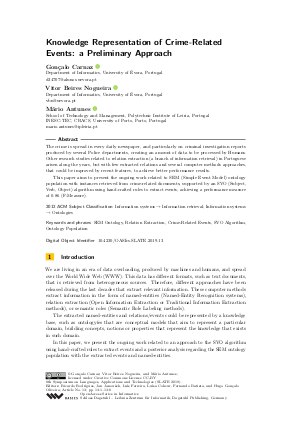Knowledge Representation of Crime-Related Events: a Preliminary Approach
Authors
Gonçalo Carnaz  ,
Vitor Beires Nogueira
,
Vitor Beires Nogueira  ,
Mário Antunes
,
Mário Antunes 
-
Part of:
Volume:
8th Symposium on Languages, Applications and Technologies (SLATE 2019)
Part of: Series: Open Access Series in Informatics (OASIcs)
Part of: Conference: Symposium on Languages, Applications and Technologies (SLATE) - License:
 Creative Commons Attribution 3.0 Unported license
Creative Commons Attribution 3.0 Unported license
- Publication Date: 2019-07-24
File

PDF
OASIcs.SLATE.2019.13.pdf
- Filesize: 0.6 MB
- 8 pages
Document Identifiers
Subject Classification
ACM Subject Classification
- Information systems → Information retrieval
- Information systems → Ontologies
Keywords
- SEM Ontology
- Relation Extraction
- Crime-Related Events
- SVO Algorithm
- Ontology Population
Metrics
- Access Statistics
-
Total Accesses (updated on a weekly basis)
0PDF Downloads0Metadata Views
Abstract
The crime is spread in every daily newspaper, and particularly on criminal investigation reports produced by several Police departments, creating an amount of data to be processed by Humans. Other research studies related to relation extraction (a branch of information retrieval) in Portuguese arisen along the years, but with few extracted relations and several computer methods approaches, that could be improved by recent features, to achieve better performance results. This paper aims to present the ongoing work related to SEM (Simple Event Model) ontology population with instances retrieved from crime-related documents, supported by an SVO (Subject, Verb, Object) algorithm using hand-crafted rules to extract events, achieving a performance measure of 0.86 (F-Measure).
Cite As Get BibTex
Gonçalo Carnaz, Vitor Beires Nogueira, and Mário Antunes. Knowledge Representation of Crime-Related Events: a Preliminary Approach. In 8th Symposium on Languages, Applications and Technologies (SLATE 2019). Open Access Series in Informatics (OASIcs), Volume 74, pp. 13:1-13:8, Schloss Dagstuhl – Leibniz-Zentrum für Informatik (2019)
https://doi.org/10.4230/OASIcs.SLATE.2019.13
BibTex
@InProceedings{carnaz_et_al:OASIcs.SLATE.2019.13,
author = {Carnaz, Gon\c{c}alo and Nogueira, Vitor Beires and Antunes, M\'{a}rio},
title = {{Knowledge Representation of Crime-Related Events: a Preliminary Approach}},
booktitle = {8th Symposium on Languages, Applications and Technologies (SLATE 2019)},
pages = {13:1--13:8},
series = {Open Access Series in Informatics (OASIcs)},
ISBN = {978-3-95977-114-6},
ISSN = {2190-6807},
year = {2019},
volume = {74},
editor = {Rodrigues, Ricardo and Janou\v{s}ek, Jan and Ferreira, Lu{\'\i}s and Coheur, Lu{\'\i}sa and Batista, Fernando and Gon\c{c}alo Oliveira, Hugo},
publisher = {Schloss Dagstuhl -- Leibniz-Zentrum f{\"u}r Informatik},
address = {Dagstuhl, Germany},
URL = {https://drops.dagstuhl.de/entities/document/10.4230/OASIcs.SLATE.2019.13},
URN = {urn:nbn:de:0030-drops-108809},
doi = {10.4230/OASIcs.SLATE.2019.13},
annote = {Keywords: SEM Ontology, Relation Extraction, Crime-Related Events, SVO Algorithm, Ontology Population}
}
Author Details
References
-
JAPJ Breukers and RJ Hoekstra. Epistemology and ontology in core ontologies: FOLaw and LRI-Core, two. Citeseer, 2004.

-
José Guilherme Mírian Bruckschen, Re-nata Vieira Souza, and Sandro Rigo. Desafios na avaliação conjunta do reconhecimento de entidades mencionadas: O Segundo HAREM. Desafios na avaliação conjunta do reconhecimento de entidades mencionadas: O Segundo HAREM, page 436, 2008.

-
Nuno Cardoso. Rembrandt-reconhecimento de entidades mencionadas baseado em relaçoes e análise detalhada do texto. quot; Encontro do Segundo HAREM (Universidade de Aveiro Portugal 7 de Setembro de 2008), 2008.

-
Pompeu Casanovas, Núria Casellas, Christoph Tempich, Denny Vrandečić, and Richard Benjamins. OPJK and DILIGENT: ontology modeling in a distributed environment. Artificial Intelligence and Law, 15(2):171-186, 2007.

-
Sandra Collovini, Gabriel Machado, and Renata Vieira. A Sequence Model Approach to Relation Extraction in Portuguese. In LREC, 2016.

-
John Davies. Lightweight ontologies. In Theory and Applications of Ontology: Computer Applications, pages 197-229. Springer, 2010.

-
Cleyton Mário de Oliveira Rodrigues, Frederico Luiz Goncalves De Freitas, and Ryan Ribeiro De Azevedo. An ontology for property crime based on events from ufo-b foundational ontology. In 2016 5th Brazilian Conference on Intelligent Systems (BRACIS), pages 331-336. IEEE, 2016.

-
Enrico Francesconi, Pier-Luigi Spinosa, and Daniela Tiscornia. A Linguistic-ontological Support for Multilingual Legislative Drafting: the DALOS Project. In LOAIT, pages 103-111, 2007.

-
Marcos Garcia and Pablo Gamallo. Evaluating various linguistic features on semantic relation extraction. In Proceedings of the International Conference Recent Advances in Natural Language Processing 2011, pages 721-726, 2011.

-
Marko Marković, Stevan Gostojić, and Zora Konjović. Structural and semantic markup of complaints: Case study of Serbian Judiciary. In 2014 IEEE 12th International Symposium on Intelligent Systems and Informatics (SISY), pages 15-20. IEEE, 2014.

-
Marguerite McDaniel, Emma Sloan, William Nick, James Mayes, and Albert Esterline. Ontologies for situation-based crime scene identities. In SoutheastCon 2017, pages 1-8. IEEE, 2017.

-
Murad Mehmet and Duminda Wijesekera. Ontological Constructs to Create Money Laundering Schemes. In STIDS, pages 21-29. Citeseer, 2010.

-
Imen Bouaziz Mezghanni and Faiez Gargouri. CrimAr: A Criminal Arabic Ontology for a Benchmark Based Evaluation. Procedia Computer Science, 112:653-662, 2017.

- Cristina Mota and Diana Santos. Desafios na avaliação conjunta do reconhecimento de entidades mencionadas: O Segundo HAREM. In Desafios na avaliação conjunta do reconhecimento de entidades mencionadas: O Segundo HAREM, chapter : Geo-ontologias e padrões para reconhecimento de locais e de suas relações em textos: o SEI-Geo no Segundo HAREM, page 436. Desafios na avaliação conjunta do reconhecimento de entidades mencionadas: O Segundo HAREM, 2008. URL: http://dx.doi.org/10.1103/PhysRevB.82.193405.
-
Quratulain Rajput, Nida Sadaf Khan, Asma Larik, and Sajjad Haider. Ontology based expert-system for suspicious transactions detection. Computer and Information Science, 7(1):103, 2014.

-
Ricardo Manuel da Conceição Rodrigues. RAPPORT: A Fact-Based Question Answering System for Portuguese. PhD thesis, Universidade de Coimbra, 2017.

-
Erick Nilsen Pereira Souza and Daniela Barreiro Claro. Extração de relações utilizando features diferenciadas para português. Linguamática, 6(2):57-65, 2014.

-
Sylvie Szulman Sylvie Despres. Construction of a legal ontology from a european community legislative text. In Legal Knowledge and Information Systems: JURIX 2004, the Seventeenth Annual Conference, volume 120, page 79. IOS Press, 2004.

-
Daniela Tiscornia. The LOIS project: Lexical ontologies for legal information sharing. In Proceedings of the V Legislative XML Workshop, pages 189-204. Citeseer, 2006.

-
Saskia Van De Ven, Rinke Hoekstra, Joost Breuker, Lars Wortel, Abdallah El Ali, et al. Judging Amy: Automated Legal Assessment using OWL 2. In OWLED, volume 432, 2008.

